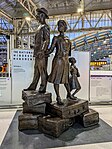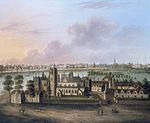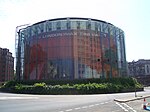Waterloo tube station
Bakerloo line stationsFormer Baker Street and Waterloo Railway stationsJubilee line stationsLondon Underground Night Tube stationsNorthern line stations ... and 7 more
Rail transport stations in London fare zone 1Railway stations in Great Britain opened in 1898Railway stations in Great Britain opened in 1906Railway stations located underground in the United KingdomTube stations in the London Borough of LambethUse British English from August 2012Waterloo & City line stations

Waterloo is a London Underground station located beneath Waterloo National Rail station. As of 2020, it is the 5th busiest station on the London Underground, with 16.62 million users. It is served by four lines: the Bakerloo, Jubilee, Northern and Waterloo & City lines. The station is situated in fare zone 1 and is located near the South Bank of the River Thames, in the London Borough of Lambeth. It is within walking distance of the London Eye.
Excerpt from the Wikipedia article Waterloo tube station (License: CC BY-SA 3.0, Authors, Images).Waterloo tube station
Station Approach, London Lambeth (London Borough of Lambeth)
Geographical coordinates (GPS) Address Nearby Places Show on map
Geographical coordinates (GPS)
| Latitude | Longitude |
|---|---|
| N 51.5025 ° | E -0.113 ° |
Address
Platforms 9 & 10
Station Approach
SE1 7EB London, Lambeth (London Borough of Lambeth)
England, United Kingdom
Open on Google Maps










